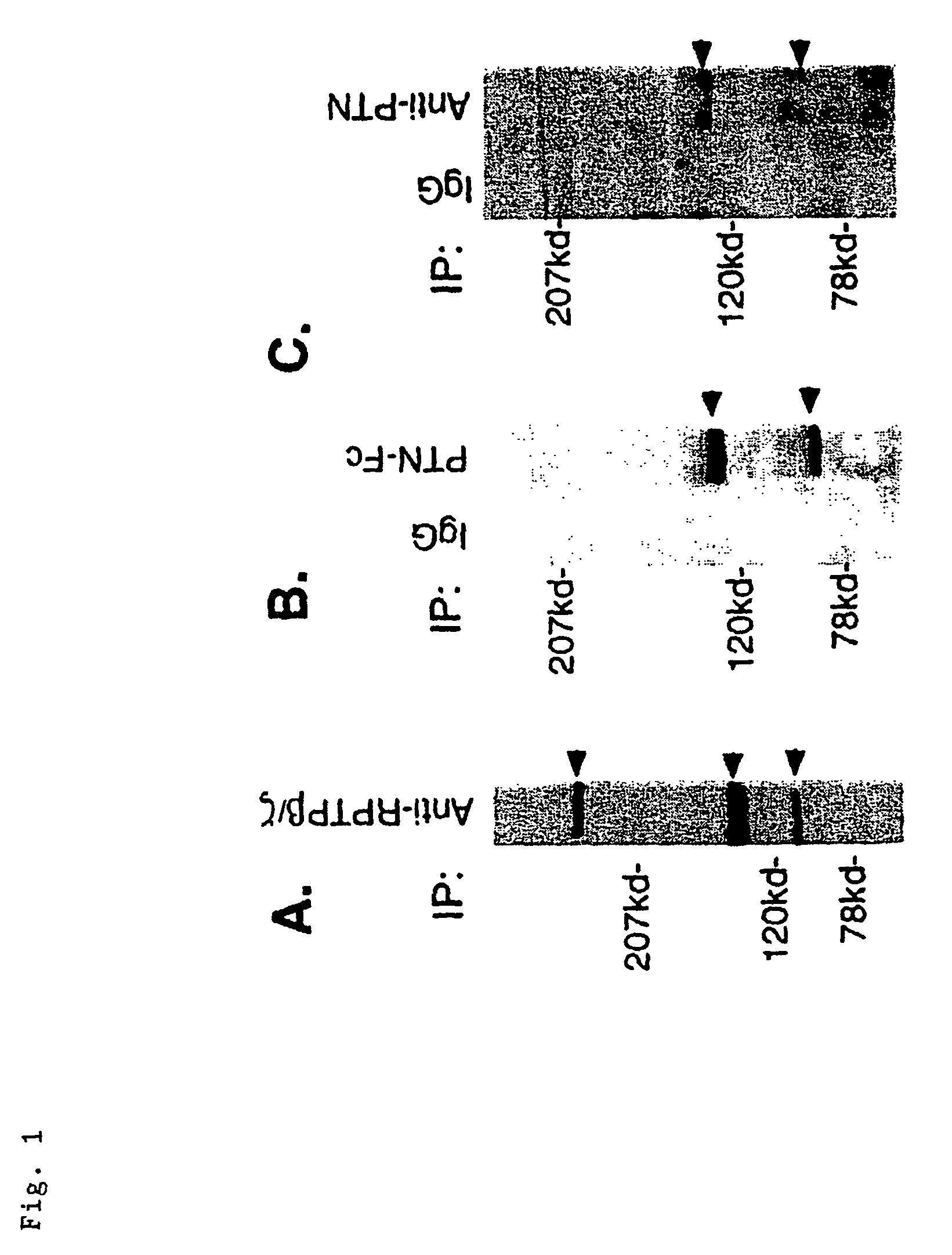Modulation of pleiotrophin signaling by receptor-type protein tyrosine phosphatase beta/zeta
a receptor-type protein and pleiotrophin technology, applied in the direction of depsipeptides, peptide/protein ingredients, peptide/protein ingredients, etc., can solve the problem of affecting the potential for cells to adhere with each other, and achieve the effect of inhibiting rptp / enzymatic activity, and reducing the level of -catenin interaction
- Summary
- Abstract
- Description
- Claims
- Application Information
AI Technical Summary
Benefits of technology
Problems solved by technology
Method used
Image
Examples
example 1
Materials and Methods
Cell Culture
[0060]U373-MG glioblastoma (American Type Culture Collection, 10801 University Boulevard, Manassas, Va., 20110-2209, USA) cells were used in all experiments and cultured in DMEM and 10% FCS unless otherwise noted.
Western Blot Analysis
[0061]U373-MG glioblastoma cells (≈106) were lysed in 50 mM Tris-HCl (pH 8.0) / 150 mM NaCl / 1 mM EDTA / 1% Triton X-100 / 1 mM phenylmethylsulfonyl fluoride / 0.5 μg / ml leupeptin / 1 μM pepstatin / 1 μg / ml aprotinin for 30 minutes at 4° C., boiled in SDS / PAGE sample buffer (25 mM Tris-HCl, pH 6.8 / 2.5% SDS / 2.5% glycerol / 5% 2-mercaptoethanol), separated by SDS / PAGE, transferred to poly(vinylidenedifluoride) membranes, probed with antibodies as indicated, and illuminated with the enhanced chemiluminescence ECL-PLUS system (Amersham Corp., Arlington Heights, Ill., USA).
Chemical Cross-Linking
[0062]U373-MG cells (≈106) were incubated with the PTN-Fc fragment of IgG (PTN-Fc) for 30 minutes at 37° C., washed with PBS, and incubated with 1 m...
example 2
RPTP β / ζ Tyrosine Phosphatase Activity
[0066]PTN-treated U373-MG cells. Confluent U373-MG cells were incubated either with DMEM alone or 50 ng / ml recombinant PTN (Sigma) at 37° C. for 15 minutes, washed three times with PBS, lysed as described above, and cleared at 14,000×g for 15 minutes 4° C. Equal amounts of lysates were incubated with α-RPTP β / ζ antibodies or mouse IgG (control) at 4° C. overnight, incubated with Protein A Sepharose-4B at 4° C. for 2 hours, and washed three times in lysis buffer and once in assay buffer (20 mM imidazole, pH 7.2 / 0.1 mg / ml BSA). The phosphatase activity of the immobilized RPTP β / ζ protein was assayed as follows: 50 μl of either RPTP β / ζ or mouse IgG immobilized on protein-A beads was added to the assay buffer, the reaction mixture (25 mM imidazole, pH 7.2 / 0.1 mg / ml BSA / 10 mM DTT / 100 nM 32P-labeled substitute Raytide) was added to a final volume of 80 μl, incubated at 30° C. for various times, terminated, and the 32P released was quantitated by a ch...
example 3
Both Exogenous PTN and the Endogenous Ptn Gene Product Interact with RPTP β / ζ
[0069]PTN-Fc was incubated with lysates of serum starved, confluent U373-MG cells, and proteins associated with PTN-FC were captured on Protein A Sepharose and probed by Western blot with anti-(α)-RPTP β / ζ antibodies (FIG. 1B). Three major and other minor alternative-spliced forms of the single RPTP β / ζ gene have been identified (28, 29, 30), and the results of the PTN-FC capture were therefore compared with Western blots of immunoprecipitates from untreated U373-MG cell lysates incubated with A-RPTP β / ζ antibodies (FIG. 1A). Major bands of ≈230, ≈130, ≈85, and variably, in other experiments, ≈250 kDa were identified (FIG. 1A), consistent with the known different spliced forms of RPTP β / ζ previously identified. Depending on the conditions of cell growth, different (presumably alternative-spliced) forms were identified. In Western blots of proteins captured by PTN-Fc from U373-MG cell lysates, two major band...
PUM
| Property | Measurement | Unit |
|---|---|---|
| volume | aaaaa | aaaaa |
| concentration | aaaaa | aaaaa |
| molecular mass | aaaaa | aaaaa |
Abstract
Description
Claims
Application Information
 Login to View More
Login to View More - R&D
- Intellectual Property
- Life Sciences
- Materials
- Tech Scout
- Unparalleled Data Quality
- Higher Quality Content
- 60% Fewer Hallucinations
Browse by: Latest US Patents, China's latest patents, Technical Efficacy Thesaurus, Application Domain, Technology Topic, Popular Technical Reports.
© 2025 PatSnap. All rights reserved.Legal|Privacy policy|Modern Slavery Act Transparency Statement|Sitemap|About US| Contact US: help@patsnap.com



